Universal mid-season cabbage variety Nadezhda
The cabbage variety Nadezhda appeared at the end of the 20th century. It quickly gained popularity among gardeners and still retains it today due to a number of advantages, including high yield, resistance to cracking, drought and frost. We will tell you about the pros and cons of the variety, the features of its cultivation and the requirements it places on planting and care.
Description of the cabbage variety Nadezhda
The variety was developed by domestic breeders. The heads of cabbage are dense, round or flat-round, the main purpose is pickling, pickling, pickling.
Origin and development
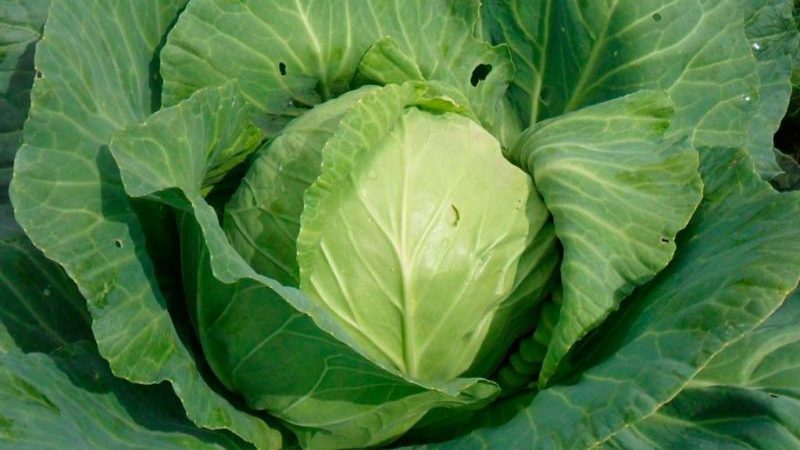
Nadezhda cabbage was bred in 1969 by specialists of the West Siberian Vegetable and Potato Breeding Experimental Station as a result of crossing the varieties Slava Enkhuizena and Dense Kochannaya.
The variety was included in the State Register of Russia in 1975. The originator is NIIOH scientist N.M. Nasrullaev.
Chemical composition and beneficial properties
100 g of vegetable contains:
- sugar - 4.4–6.7%;
- vitamin C - 24–39 mg;
- B5 - 0.2 mg;
- E - 0.1 mg;
- B6 - 0.1 mg;
- B2 - 0.04 mg;
- B1 - 0.03 mg;
- phosphorus - 31 mg;
- calcium - 48 mg;
- chlorine - 37 mg.
The chemical composition varies depending on the growing region: in the southern regions, cabbage contains less sugars and more vitamin C.
The vegetable helps normalize metabolic processes, has anti-inflammatory and analgesic properties, and is useful for atherosclerosis, gout, heart and kidney pathologies.
Features of application
Nadezhda cabbage is suitable for pickling, pickling and pickling.It is consumed fresh, stewed, and added to salads and first courses.
Ripening time and yield
This is a mid-season variety of cabbage - the crop is ready for harvesting 120–125 days after germination or 95 days after planting the seedlings in a permanent place.
Marketable yield is 696–1128 c/ha, maximum – 1450 c/ha.
Resistance to diseases, pests and cold
The variety is resistant to blackleg and gray rot, but is susceptible to clubroot, bacteriosis, caterpillars, midges and aphids.
Nadezhda cabbage tolerates frosts down to -5°C. The optimal temperature for its growth is +15…+20°C. Hot (above +25°C) weather contributes to the accumulation of nitrates in heads of cabbage.
Characteristics
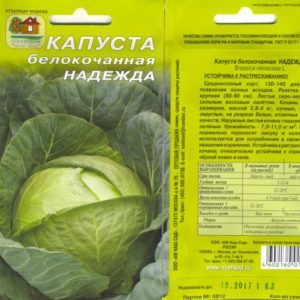
Plant 40–60 cm high with a semi-spreading rosette of leaves. The heads of cabbage are dense, round or rounded-flat in shape, reach 60–80 cm in diameter and weigh 2.4–3.4 kg.
The outer leaves are medium-sized, round, wrinkled, slightly wavy at the edges, colored light green and covered with a thin layer of waxy coating. In cross-section, the forks are white, the outer stalk is of medium length, the inner one is short.
The heads of cabbage are juicy and tender, characterized by a balanced taste that combines sweetness, sourness and slight bitterness.
What regions is it suitable for?
Thanks to its frost resistance and ability to adapt to unstable climatic conditions, the variety is successfully cultivated in Siberia, the Urals, the Far East, central Russia and other regions.
Advantages and disadvantages
The main advantages of the variety:
- stable and high productivity;
- universal use of heads of cabbage;
- lack of tendency to cracking and discoloration;
- good keeping quality and transportability;
- drought and frost resistance;
- high commercial qualities;
- immunity to blackleg and gray rot.
The disadvantages of Nadezhda include a tendency to be affected by clubroot and bacteriosis.
Differences from other varieties and hybrids
A comparison of Nadezhda with other mid-season cabbage varieties is presented in the table:
| Variety | Head shape | Head weight, kg | Average yield, c/ha |
| Hope | Round or round-flat | 2,4–3,4 | 696–1128 |
| Grandma's pickle | Round | 1,5–2,9 | 416–651 |
| Belorusskaya 455 | 1,3–4,1 | 474–785 | |
| Brer Rabbit | 1,9–3,7 | 296–595 |
Features of planting and growing
Nadezhda cabbage is grown by seedlings or without seedlings. The main thing is to observe the timing of sowing seeds, choose the right location on the site and take into account the climate of the region.
Preparing to plant seeds and seedlings
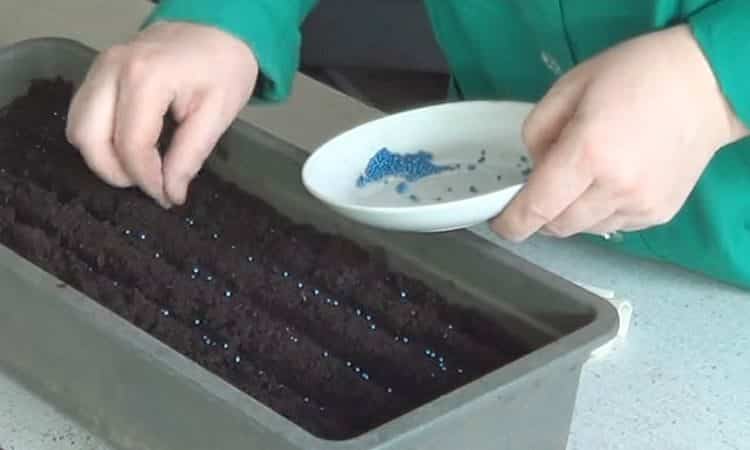
Seeds for seedlings are sown in early April. Soil consisting of equal parts of garden soil, sand and peat is poured into the prepared containers, which is spilled with a weak solution of potassium permanganate for disinfection. The planting material is pre-calibrated, soaked in a solution of potassium permanganate for half an hour, then immersed in hot (+50°C) water for half an hour and in cold water for 2-3 minutes.
The prepared seeds are buried 1–1.5 cm in moist soil, watered, the containers with the crops are covered with polyethylene and put in a warm (+20…+22°C) place. After germination, the temperature in the room with seedlings is maintained at +12...+15°C during the day and +8...+10°C at night.
Reference. Daylight hours for plants should last 12–15 hours. If necessary, fluorescent lamps or special phytolamps are used for additional lighting.
Water the seedlings moderately, making sure that the soil does not dry out or become overly moist. When the seedlings have 1-2 true leaves, pick them, planting the plants in individual containers and getting rid of weak specimens.
After picking, the seedlings are fed with complex mineral fertilizers, and 10 days before transplanting into open ground they begin to harden them: they are taken out into fresh air and the time spent there is gradually increased from 15 minutes to a day.
During hardening, foliar feeding is carried out: the leaves are sprayed with a solution of potassium sulfate and urea at the rate of 250 ml per 1 bush.
How to plant without seedlings
In the southern regions, it is permissible to sow seeds directly into open ground.
In this case, the seeds are planted in late April - early May. The beds are formed at a distance of 75–80 cm from each other, with 50–70 cm between holes. 2-3 grains are placed in each planting hole and covered with film or glass. When the seedlings reach a height of 10–15 cm, remove weak sprouts, leaving only large and strong ones.
The growing season when grown without seedlings is reduced by 15–18 days.
Soil requirements and predecessors
Cabbage is planted in a well-lit place, protected from gusty winds and drafts. Due to the lack of light, the crop takes longer to ripen, the heads of cabbage accumulate more nitrates, lose density and are stored less.
Nadezhda prefers light, loose and fertile soil with sufficient nitrogen, calcium and potassium content and neutral or medium acidity (pH 6.4–7.5). The best option is slightly loamy and loamy soil.
Reference. Acidic soil is first limed or dolomite flour is added to it.
The best predecessors - melons and nightshades.
Dates, scheme and rules of planting
Seedlings are transplanted into open ground at the age of 30–45 days. By this time, the plants will reach a height of 20 cm and form 5-6 leaves.
In central Russia, replanting is carried out in mid-May, focusing on weather conditions and soil temperature (it should be warmed up to +4...+12°C).
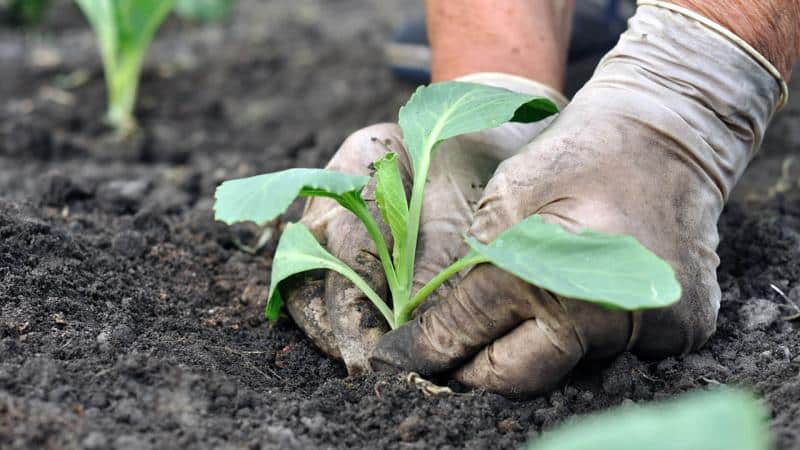
Landing rules:
- On a site prepared and fertilized in the fall, beds are formed at a distance of 70–80 cm from each other.
- Every 50–60 cm, holes are made in them with a depth of 25 cm.
- Add a mixture of humus, wood ash and potassium-containing fertilizers to each handful, pour in 2 liters of water.
- The seedlings are removed from the containers and placed in the center of the prepared holes.
- Cover the plants with soil so that they are buried down to the first leaves, and compact the soil.
After transplanting, the plants are watered abundantly.
Nuances of care
To obtain a high-quality and abundant harvest, cabbage is provided with optimal conditions for growth and the agrotechnical requirements of the crop are observed: plantings are watered and fertilized in a timely manner, the soil is weeded and loosened, the cabbage is hilled and protected from diseases and pests.
Watering mode

The frequency of watering depends on the air temperature and the amount of precipitation. On average, for 2 weeks after transplanting seedlings, watering is carried out every 3 days, using 8–10 liters of settled water at street temperature per 1 m². Then the cabbage is watered once a week at the rate of 15 liters of water per 1 m².
Important! Excessive watering and waterlogging of the soil provoke the development of bacteriosis.
Despite the resistance to cracking of the heads of cabbage, irrigation is stopped 2 weeks before harvesting.
Loosening and hilling
After each watering or rain, the soil is loosened to improve the access of oxygen and moisture to the roots. At the same time, they get rid of weeds.
Cabbage is hilled three times per season: 2 weeks after transplanting the seedlings, then twice more with an interval of 15–20 days.
Top dressing
Fertilizers are applied according to the following scheme:
- 14 days after transplanting seedlings - nitrogen-containing fertilizers;
- at the beginning of the formation of heads of cabbage - fertilizers containing nitrogen, phosphorus and potassium;
- after 2 weeks - superphosphate.
Organic fertilizers include mullein or chicken manure infusion diluted in water and dry wood ash. Mineral fertilizers are dissolved in water and applied at the root.
Measures to increase yield
The quality and quantity of the harvest directly depend on compliance with the rules for caring for cabbage. It is important to regularly water, preventing the soil from drying out or becoming waterlogged, to promptly apply fertilizers that promote the growth and development of the crop, and not to neglect the preventive treatment of plantings against diseases and pests.
Read also:
Ornamental cabbage: cultural features
Sowing and features of growing Japanese cabbage
How to prepare Korean cauliflower for the winter: a classic recipe and its variations
Disease and pest control
Diseases and pests dangerous to Nadezhda:
| Disease/pest | Signs | Treatment |
| Kila | The leaves lose turgor, turn yellow and wither, the forks fall to one side. | The disease cannot be cured. Infected plants are dug up and burned, and the soil is watered with copper sulfate. |
| Bacteriosis | The seedlings develop slowly, the roots become bent, the cotyledons of the seedlings become lighter, the veins on the leaves turn black, and as a result the plants die. If the disease develops during the ovary of the heads of cabbage, they form small and loose. | Specimens affected by bacteriosis are uprooted and burned, healthy plants are sprayed with Planriz. |
| Caterpillars | Sticky coating, holes or yellow spots appear on the leaves. | Plantings are sprayed with an ash-soap solution, garlic broth or an infusion based on wormwood, onion peels or ammonia. The soil is sprinkled with dolomite flour or wood ash. If folk remedies do not produce results, insecticides are used (Aktaru, Actofit, Karate, Zeon, Calypso). |
| Aphid | ||
| Midges |
Difficulties in growing
Problems that vegetable growers face when growing Nadezhda:
- The heads of cabbage are formed small and loose. The cabbage probably grows in partial shade and lacks sunlight.
- Yellowing of leaves, loss of turgor. The main symptoms of clubroot, which, in the absence of other causes, develops as a result of planting a crop in soil with high acidity.
Harvest and storage
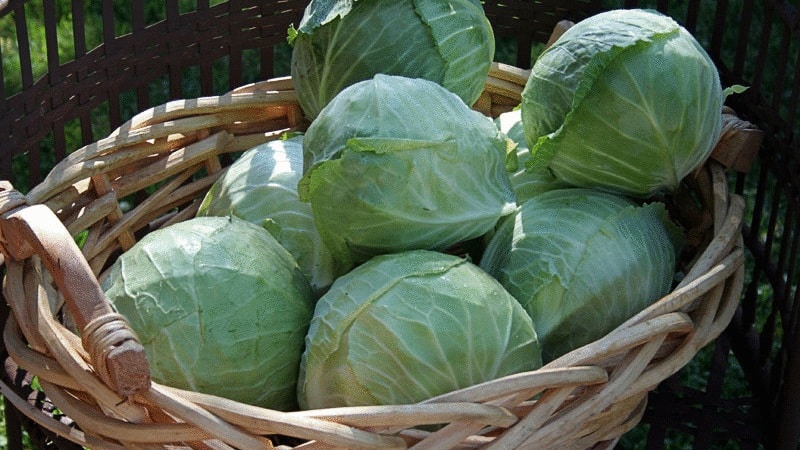
The harvest is harvested in August – September. More precise dates are determined by the condition of the heads of cabbage: they will become dense, voids will not be felt, and the lower leaves will droop.
The cabbage is dug up with roots, the heads are cut off, leaving 3-4 covering leaves and a stalk 3-4 cm long. The harvest is inspected and put aside for early consumption, or specimens that have mechanical damage or signs of disease are thrown away.
Heads of cabbage suitable for storage are taken to a cellar or basement, where under proper conditions (air temperature - -1...+1°C, humidity level - 90–98%) they are stored for 5-6 months.
Tips and reviews from experienced gardeners
Experienced vegetable growers recommend:
- plant cabbage in the same place no more than once every 3-4 years;
- To repel pests, plant thyme, coriander, sage, celery or anise near cabbage beds.
Gardeners speak positively about the Nadezhda variety.
Maria, Bryansk region: “I have been growing this variety for more than 10 years.I like that it does not require any specific and labor-intensive care. If you choose a well-lit place for cabbage and carefully monitor the frequency of watering, a bountiful harvest will be ensured. The heads of cabbage are dense, store well, and are very tasty.”
Maxim, Vladivostok: “I am a farmer with extensive experience; I have been growing various crops, including cabbage, for a long time, not only for myself, but also for sale. I like Nadezhda because it consistently produces a rich and high-quality harvest, rarely gets sick, and is ideal not only for fresh consumption, but also for processing.”
Read also:
The best Dutch varieties and hybrids of white cabbage
The best varieties of cabbage for pickling and storing for the winter
Conclusion
Among the advantages of the Nadezhda variety are the friendly ripening of heads of cabbage, consistently high yields, the possibility of universal use of cabbage, resistance to cracking, flowering, drought and frost, good commercial qualities and a long shelf life. Among the minuses of Nadezhda, they mention the tendency to be affected by bacteriosis and clubroot.